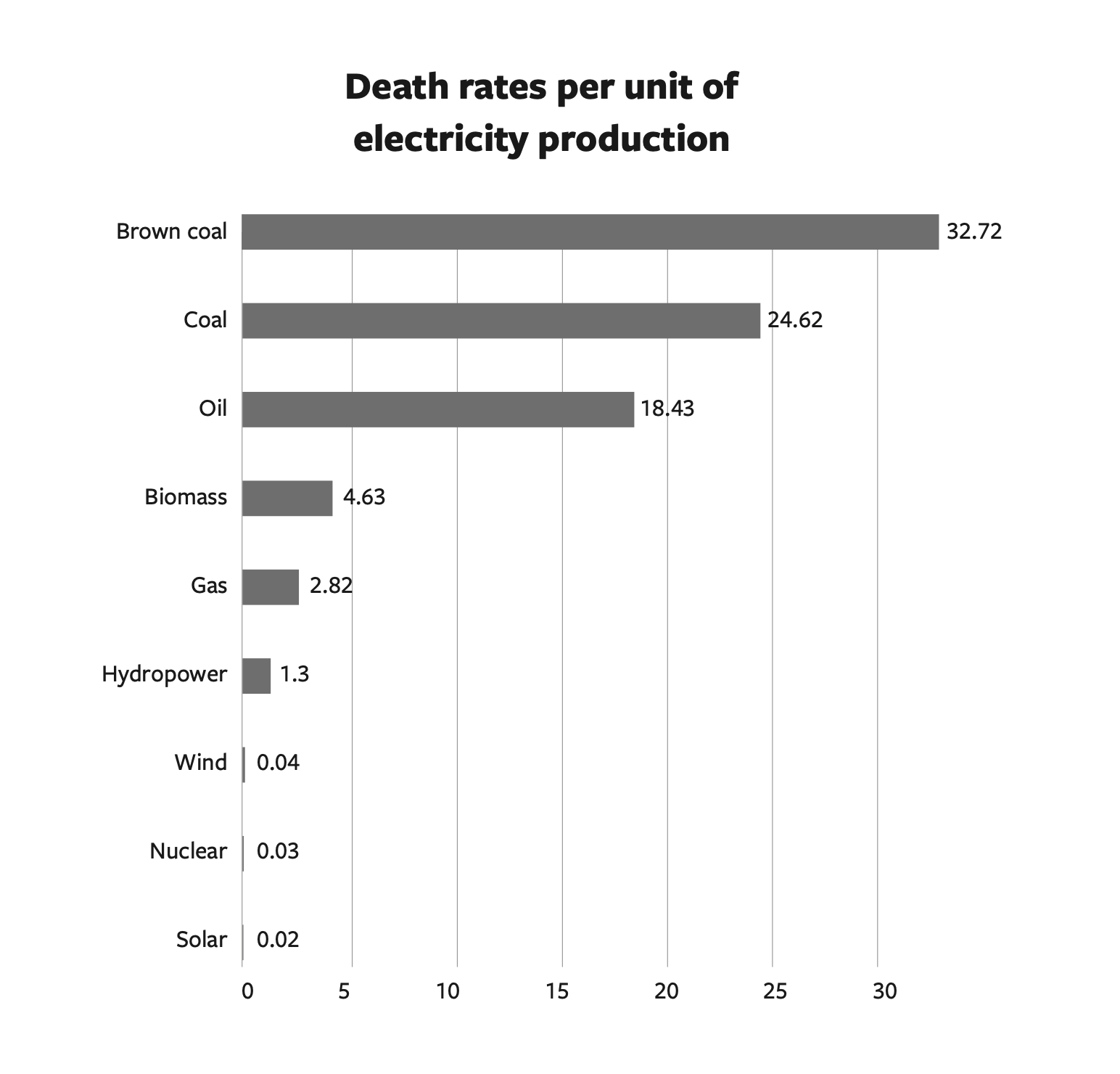Chapter 10: Safety
by Brian Gitt
Solar wins | Runner-up: Nuclear
Energy solutions need to be safe. They need to minimize loss of life, negative health effects, and workplace accidents. One way of evaluating the safety of an energy source is to examine how many people die from accidents or from the air pollution that the source produces for every unit of electricity it produces. The following graph compares the safety record of various energy sources (data here).
Three energy sources have truly outstanding safety records: solar, nuclear, and wind, in that order. No other energy sources even come close.
Solar power plants win because they don’t emit any air pollution while operating, and they don’t have moving parts that can injure people. Rooftop solar installers can fall off roofs, but most solar power production comes from large, ground-mounted solar arrays with minimal risk to worker safety.
The wind energy industry also has a strong safety record. Fatalities from accidents during wind turbine installation are relatively rare, and the industry has implemented strict safety standards and training programs to minimize the risk of accidents. According to a report by the National Renewable Energy Laboratory (NREL), there were 38 fatalities associated with wind energy operations in the United States from 2003 to 2014.
Nuclear power doesn’t emit any air pollution while operating, and regulatory agencies require licensed nuclear plants to prove that their system is protected against all credible external events. In addition, the nuclear industry upholds the most stringent occupational safety standards on earth, which makes nuclear plants one of the safest places to work. Based on rates of occupational injuries, nuclear is:
4X safer than hydroelectric power generation;
5X safer than fossil fuel power generation;
6X safer than electric power transmission; and
6X safer than natural gas distribution.
Small nuclear plants are designed to be walk-away safe, meaning they are designed to shut down safely in the event of an emergency without the need for any human intervention or external power sources.
Many people fear nuclear power because they fear radiation. But radiation exists everywhere. You're exposed to radiation when you eat, drink, sleep, and walk outside. The average US home exposes you to 228 times more radiation than you get from living near a nuclear power plant, according to EPA data. Airline flight crews are exposed to ~5 times more radiation flying from New York to Tokyo than workers at nuclear power plants. The nuclear power industry accounts for less than 0.1% of background radiation.
But let’s address the radioactive elephant in the room: nuclear accidents like Chernobyl, Fukushima, and Three Mile Island.
The Three Mile Island accident caused no injuries, no deaths, and no adverse health effects. The radiation exposure to nearby residents was the equivalent of that received from a vacation in the mountains. The Fukushima accident resulted in one death from radiation exposure. Chernobyl was the worst nuclear accident in history. It directly killed 30 workers from the blast effects and radiation exposure. The general population was also exposed to radiation. However, in part because of the countermeasures taken, the resulting radiation doses were relatively low (the average additional dose in 1986–2005 in “contaminated areas” was equivalent to that from a computed tomography (CT) scan in medicine, and should not lead to substantial health effects in the general population. The civilian mortality from Chernobyl contamination is 15 thus far, in each case from thyroid cancer. The combined confirmed death toll from Chernobyl is less than 100. But Chernobyl was an isolated incident, and the reactor had serious design flaws. For example, it didn’t have a concrete containment dome—a standard safety feature in today’s reactors. It’s physically impossible that a nuclear reactor operating today could have a similar accident.
When we look at the actual facts about these cases, people’s fears don’t match reality. They falsely believe nuclear energy is dangerous—like they falsely believe airplanes are more dangerous than cars. About 100 people have died as a result of radiation from nuclear accidents in over 60 years. By contrast, millions die every year from the effects of coal.
Ironically, people’s fears about nuclear power have caused more deaths than nuclear power itself. Consider Japan. It shut down all its nuclear power plants after the Fukushima accident. As a result, electricity prices soared up to 40% which caused over 1,280 deaths during cold temperatures from 2011 to 2014. To this day, only one death from radiation is attributed to Fukushima: a man who died of lung cancer many years after the accident. He was also a smoker.
